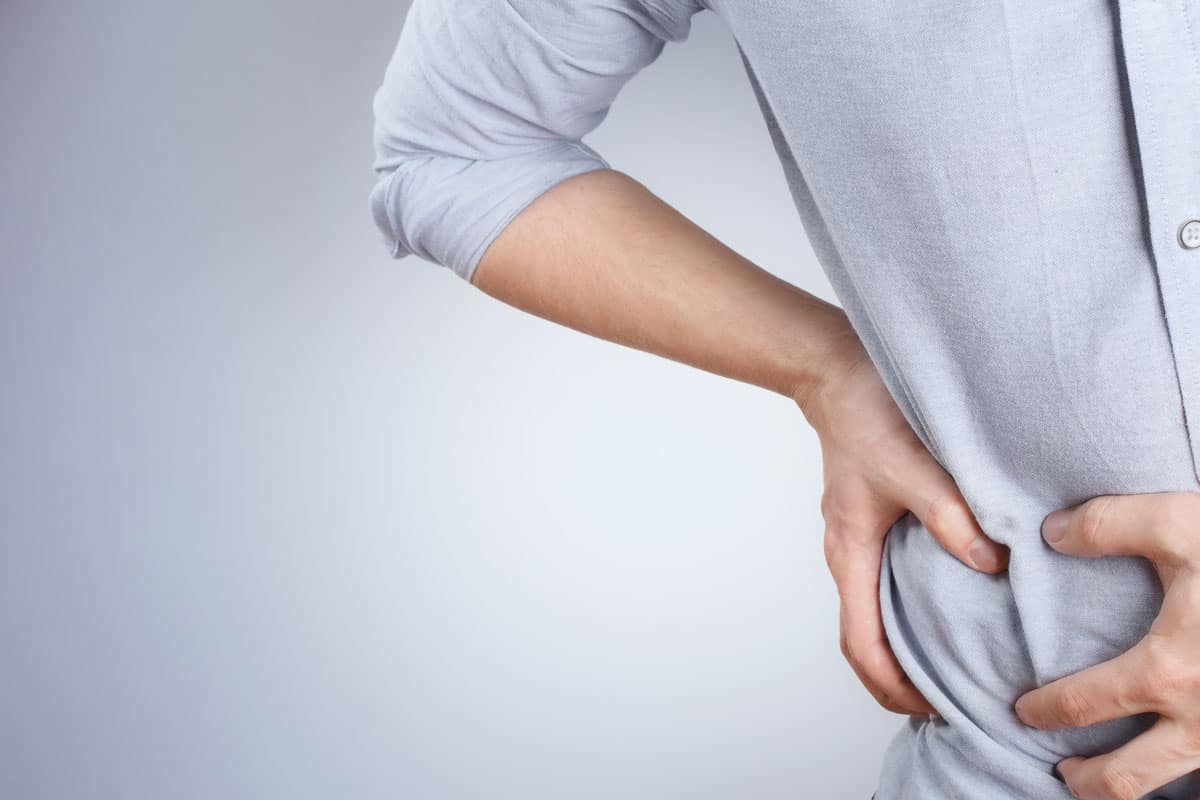Share this post
How it works, what goes wrong, and how to keep it working well
When most people think of digestion, they think of the stomach and the 25-feet of intestines winding their way through the abdomen. These organs are, indeed, vital for the absorption of food nutrients and the elimination of waste. However, one organ which we easily neglect (and often remove!) also has tremendous importance as a part of our digestive system: the gallbladder.
A crash course in gastrointestinal physiology
Before we get to the gallbladder, we have to step back a few steps, and follow what happens with food from the second it enters our mouth (and even before). Our body actually begins to secrete increased amounts of some important digestive substances when we smell food.[1] Many have realized this if they ever smelled an Italian meal being prepared – the very smell starts to make us hungry!
The digestion of food begins in the mouth, where we chew food with our teeth, mixing it with our saliva. Saliva contains amylase, an enzyme that starts to digest the food we are eating, breaking down carbohydrates into smaller molecules.[2] Many people have done the basic biology experiment of chewing a saltine cracker a small amount and then adding it to a small container with water (and a bit more saliva) and observed the next day how the enzymes in saliva broke it down. (If you haven’t done this give it a try!)
After we swallow, the food/amylase mixture passes down the esophagus and enters the stomach, where it is further digested by hydrochloric acid into a semi-fluid mass called chyme.[3] The stomach also mechanically starts breaking down food with its churning action. The chyme then leaves the stomach and enters the duodenum (the first part of the small intestine), where bile from the gallbladder and enzymes from the pancreas join the mix. The pancreas and gallbladder are both joined to the duodenum through a series of channels known as the biliary tract (a place where gallstones at times can be stuck).
Parasympathetic function – also known as the “rest and digest” branch of the nervous system – kicks in during mealtime. This triggers the small intestine to release a hormone known as cholecystokinin (CCK), which stimulates the release of bile from the gallbladder and the production of digestive enzymes by the pancreas.
The nervous system also plays an important role in the digestive process. Both the pancreas and gallbladder require input from the brain in order to function properly, and also have a feedback loop via which they send information back to the brain.[4] Parasympathetic function – also known as the “rest and digest” branch of the nervous system – kicks in during mealtime. This triggers the small intestine to release a hormone known as cholecystokinin (CCK), which stimulates the release of bile from the gallbladder and the production of digestive enzymes by the pancreas.[5],[6] CCK also inhibits food intake when we are full through the vagus nerve, an important nerve which helps to regulate not only the digestive system but also cardiovascular system and beyond.[7]
Gallbladder doing its job, and gallbladder gone wrong
The main function of the gallbladder in digestion is to eject bile (produced by the cells in the liver) which helps break down fats. If you’ve ever had oil on your hands, you’ve noticed that water alone doesn’t wash it off; you need to use some soap. Bile salts are like “soap” for the digestive tract – they act like a detergent to solubilize lipids. The solubilized lipids are then absorbed and enter into circulation. This includes not only meal-related fats, but also the fat-soluble vitamins (A, D, E, and K). So, when there are gallbladder problems, or if the gallbladder is removed, supplementation of these necessary vitamins may become more important because the body simply does not digest them as well.
When there are gallbladder problems, or if the gallbladder is removed, supplementation of the fat-soluble vitamins (A, D, E, and K) as well as essential fatty acids may become more important because the body simply does not digest them as well.
If the gallbladder doesn’t contract enough to push the bile out (known as biliary stasis), or if there is excess cholesterol (or bilirubin – a product of red blood cell breakdown) relative to bile salts in the gallbladder, this can lead to gallbladder stones and/or sludge.[8] Gallbladder stones can then lodge into the openings in the gallbladder and/or the tract that connects both it and the pancreas to the duodenum causing severe pain and a medical emergency. Gallstones can also be a low-grade issue and lead to post-mealtime pain (particularly with fatty meals). When larger gallstones exist in the gallbladder, they can lead to chronic irritation and tissue inflammation which can further contribute to the development of gallbladder cancer.
Gallbladder hypomotility or poor bile ejection can be associated with certain disease conditions or may be a functional issue. Gallbladder tone is regulated by smooth muscle activity, hormones, and neurotransmitters released from the nerves which are connected to it.[9] Diminished gallbladder motility may occur with neuropathy of diabetes mellitus, as well as other conditions that affect nervous system function like a spinal cord injury.[10],[11] Animal studies have shown that the lack of CCK induces gallbladder hypomotility (which can occur due to stress![12]), prolonging the time that excess cholesterol resides in the gallbladder.[13]
Risk factors for gallstone formation include being female in gender, obese, and/or pregnant, using estrogen therapies, rapidly losing weight, having diabetes mellitus, and/or a family history of gallbladder disease.[14] Individuals hemolytic disorders such as sickle cell disease or hereditary spherocytosis also have an increased risk for forming gallstones due to higher levels of bilirubin, the product of red blood cell breakdown, in their body. Native Americans are an ethnic group with a higher risk for gallstones, while African Americans have been observed to have the lowest risk.[15] Historically, hemolytic disease was primary risk factor in children, while now gallstone disease in children is more often associated with obesity.[16]
Symptoms of gallbladder dysfunction and gallstones may include right upper quadrant pain, nausea, changes in stool color, fat malabsorption (possibly noticed as a fatty film in the toilet bowl after a bowel movement), and difficulty digesting fatty foods.
Symptoms of gallbladder dysfunction and gallstones may include right upper quadrant pain, nausea, changes in stool color, fat malabsorption (possibly noticed as a fatty film in the toilet bowl after a bowel movement), and difficulty digesting fatty foods. If a stone blocks the opening of the gallbladder, there may be nausea and even vomiting. Symptoms commonly occur after a meal or snack with increased fat content, and it may hurt to press under the edge of the ribcage on the right side of the chest, where the gallbladder is located, particularly when taking a deep breath in.[17]
The presence of larger gallstones (even when asymptomatic) is associated with increased risk of gallbladder cancer, so doctors sometimes recommend cholecystectomy (surgical removal of the entire gallbladder) as it addresses both the stones and prevents problems down the line. In individuals with hemolytic anemia (particularly those who have already experienced gallstones due to this), gallbladder removal is also recommended. However, only about 30% of patients with asymptomatic gallstones have been observed to require surgery during their lifetime,[18] begging the question – must the gallbladder always be removed?
How can we help the gallbladder out?
A deficiency of ascorbic acid (vitamin C) is associated with the development of gallstones, so supplementation may help to prevent their formation.[19],[20] Increased consumption of fruits, vegetables, nuts, polyunsaturated and monounsaturated fats, and coffee (hooray!) has also been shown to reduce the risk of gallstone formation in some individuals.[21],[22],[23],[24] Higher levels of physical activity have been shown to reduce the incidence of symptomatic gallstones, while individuals with a sedentary lifestyle are at increased risk of needing to have their gallbladders removed.[25]
A deficiency of taurine, an amino acid, has been shown to lead to increased cholesterol gallstone formation, while supplementation with taurine reduced the incidence of gallstones, likely due to enhanced cholesterol degradation and the excretion of bile acid.[26],[27],[28] Ox bile, taken as a supplement, supports the production and flow of bile, which may reduce stone formation and improve fat absorption. Dietary fat consumption promotes gallbladder emptying, so it is important to make sure the diet contains adequate amounts of fats to promote normal, healthy gallbladder ejection.[29]
For individuals who have had their gallbladder removed, supplemental ox bile can be a life-changing support. Taken with meals, it provides replacement for the secretions from the now-absent gallbladder, helping to breakdown fats and reduce meal-related distress and discomfort. Additionally, supplementation with important fats such as essential fatty acids and the fat-soluble vitamins A, D, E, and K may be more important as they can have diminished absorption after gallbladder removal.[30]
For individuals who have had their gallbladder removed, supplemental ox bile can be a life-changing support. Ox bile, taken as a supplement, also supports the production and flow of bile, which may reduce stone formation and improve fat absorption.
Supporting the nervous system may improve a variety of digestive complaints as the vagus nerve plays a significant role in digestion, including gallbladder ejection.[31] Consumption of fat may play a role in digestive function via interactions with the parasympathetic nervous system as well. Increased levels of fat in the gut has been shown to stimulate parasympathetic outflow (via the vagus nerve) and mediate by CCK release.[32],[33] Other interventions which support parasympathetic balance and improved digestion include making time for meals, engaging in a meditative or mindfulness practice including at meal times, eating meals in less stressful settings (away from the laptop or work environment), and other stress management techniques.
Click here to see References
[1] Mattes RD, et al. Nutritional implications of the cephalic-phase salivary response. Appetite. 2000 Apr;34(2):177-83.
[2] Peyrot des Gachons C, Breslin PA. Salivary Amylase: Digestion and Metabolic Syndrome. Curr Diab Rep. 2016 Oct;16(10):102.
[3] Kong F, Singh RP. Disintegration of solid foods in human stomach. J Food Sci. 2008 Jun;73(5):R67-80.
[4] Costa M, et al. Anatomy and physiology of the enteric nervous system. Gut. 2000 Dec;47 Suppl 4:iv15-9.
[5] Raybould HE. Mechanisms of CCK signaling from gut to brain. Curr Opin Pharmacol. 2007 Dec;7(6):570-4.
[6] Schjoldager BT. Role of CCK in gallbladder function. Ann N Y Acad Sci. 1994 Mar 23;713:207-18.
[7] Porges SW. Cardiac vagal tone: a physiological index of stress. Neurosci Biobehav Rev. 1995 Summer;19(2):225-33.
[8] Donovan JM. Physical and metabolic factors in gallstone pathogenesis. Gastroenterol Clin North Am. 1999 Mar;28(1):75-97.
[9] Portincasa P, et al. Smooth muscle function and dysfunction in gallbladder disease. Curr Gastroenterol Rep. 2004 Apr;6(2):151-62.
[10] Várkonyi TT, et al. Gallbladder hypomotility in diabetic polyneuropathy. Clin Auton Res. 2001 Dec;11(6):377-81.
[11] Baltas CS, et al. Gallstones and biliary sludge in Greek patients with complete high spinal cord injury: an ultrasonographical evaluation. Singapore Med J. 2009 Sep;50(9):889-93.
[12] Earley RL, et al. The gall of subordination: changes in gall bladder function associated with social stress. Proc Biol Sci. 2004 Jan 7;271(1534):7-13.
[13] Wang HH, et al. Effect of gallbladder hypomotility on cholesterol crystallization and growth in CCK-deficient mice. Biochim Biophys Acta. 2010 Feb;1801(2):138-46
[14] Lambou-Gianoukos S, et al. Lithogenesis and bile metabolism. Surg Clin North Am. 2008 Dec;88(6):1175-94.
[15] Shaffer EA. Epidemiology and risk factors for gallstone disease: has the paradigm changed in the 21st century? Curr Gastroenterol Rep. 2005 May;7(2):132-40.
[16] Mehta S, et al. Clinical characteristics and risk factors for symptomatic pediatric gallbladder disease. Pediatrics. 2012 Jan;129(1):e82-8.
[17] Trowbridge RL, et al. Does this patient have acute cholecystitis? JAMA. 2003 Jan 1;289(1):80-6.
[18] Schirmer BD, et al. Cholelithiasis and cholecystitis. J Long Term Eff Med Implants. 2005;15(3):329-38.
[19] Simon JA, et al. Serum ascorbic acid and gallbladder disease prevalence among US adults: the Third National Health and Nutrition Examination Survey (NHANES III). Arch Intern Med. 2000 Apr 10;160(7):931-6.
[20] Walcher T, et al. Vitamin C supplement use may protect against gallstones: an observational study on a randomly selected population. BMC Gastroenterol. 2009 Oct 8;9:74.
[21] Tsai CJ, et al. Fruit and vegetable consumption and risk of cholecystectomy in women. Am J Med. 2006 Sep;119(9):760-7.
[22] Tsai CJ, et al. A prospective cohort study of nut consumption and the risk of gallstone disease in men. Am J Epidemiol. 2004 Nov 15;160(10):961-8.
[23] Tsai CJ, et al. The effect of long-term intake of cis unsaturated fats on the risk for gallstone disease in men: a prospective cohort study. Ann Intern Med. 2004 Oct 5;141(7):514-22.
[24] Zhang YP, et al. Systematic review with meta-analysis: coffee consumption and the risk of gallstone disease. Aliment Pharmacol Ther. 2015 Sep;42(6):637-48.
[25] Leitzmann MF, et al. Recreational physical activity and the risk of cholecystectomy in women. N Engl J Med. 1999 Sep 9;341(11):777-84.
[26] Chen W, et al. The effect of taurine on cholesterol degradation in mice fed a high-cholesterol diet. Life Sci. 2004 Feb 27;74(15):1889-98.
[27] Yamanaka Y, et al. Effect of dietary taurine on cholesterol gallstone formation and tissue cholesterol contents in mice. J Nutr Sci Vitaminol (Tokyo). 1985 Apr;31(2):225-32.
[28] Chen W, et al. The effect of taurine on cholesterol metabolism. Mol Nutr Food Res. 2012 May;56(5):681-90.
[29] Marciani L, et al. Effects of various food ingredients on gall bladder emptying. Eur J Clin Nutr. 2013 Nov;67(11):1182-7.
[30] Schmidt DR, et al. Regulation of bile acid synthesis by fat-soluble vitamins A and D. J Biol Chem. 2010 May 7;285(19):14486-94.
[31] Rogers RC, et al. Vagal control of digestion: modulation by central neural and peripheral endocrine factors. Neurosci Biobehav Rev. 1996;20(1):57-66.
[32] Raybould HE. Mechanisms of CCK signaling from gut to brain. Curr Opin Pharmacol. 2007 Dec;7(6):570-4.
[33] Tracey KJ. Fat meets the cholinergic antiinflammatory pathway. J Exp Med. 2005 Oct 17;202(8):1017-21.
The information provided is for educational purposes only. Consult your physician or healthcare provider if you have specific questions before instituting any changes in your daily lifestyle including changes in diet, exercise, and supplement use.
Share this post
Dr. Carrie Decker
Related posts
The Benefits of Berry Polyphenols
The abundant polyphenols found in berries deliver numerous health benefits Of all fruits, the consumption of fresh berries is something we oft seek out more than their somewhat more boring apple or banana counterparts. Whether it be berry smoothies; berry cobblers, pies, or crisps; homemade berry wines; or simply fresh berries eaten by the…
Fighting Depression and Anxiety Through the Gut
Vagus nerve stimulation for mood support (Part 2 of 2) Last week’s post examined the vagus nerve (the tenth cranial nerve) and the important role it plays in connecting the body to the brain. We explored how breath, laughter, and exercise all “tickle” the nerve to send soothing, calming signals to the brain and…
Leaky Gut 101
Why intestinal permeability causes so much harm, and what to do about it Brilliantly packed within the body, the intestinal barrier covers a surface area of over 4,000 square feet and requires about 40% of the body’s energy expenditure. But what happens when it starts to break down? What is leaky gut? Hold up…
Digestives Enzymes – The Fix for Your Digestive Discomfort?
The important role of the pancreas and digestive enzymes on health There are so many supplements out there designed to support digestion, and probiotics seem to be getting all the limelight. However, many are surprised to find that digestive enzymes (also known as pancreatic enzymes) often have a far greater impact on digestive symptoms…
Vaccine Efficacy, Part 1 of 2: Can a Healthy Diet Improve It?
The influence of dietary fiber, prebiotics, beta-glucan, and fucoidan Vaccines are one of the greatest successes of modern medicine, helping to protect entire populations against a wide range of infectious diseases.[1] A vaccine works by training the immune system to recognize and combat pathogens, either viruses or bacteria. To do this, certain molecules (antigens)…
What’s Wrong With My Poop?
Common factors that contribute to digestive system problems Many people experience a change in stool from time-to-time – what one has eaten, medications and supplements, a shift in the normal morning schedule, and emotional events all may contribute to irregular “pooping” patterns. However, a considerable number of people have a tendency towards bowel trouble,…
Categories
- Botanicals (56)
- GI Health (53)
- Healthy Aging (121)
- Immune Support (39)
- In The News (39)
- Kids Health (21)
- Stress and Relaxation (50)
- Uncategorized (1)
- Video (9)
- Vitamins & Minerals (51)




